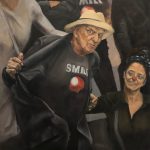FLEA HAS ENTERED THE BUILDING
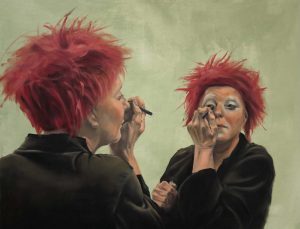
About this series
This series originated during the Corona crisis. The woman depicted is Grada. I knew her from the improvisation sessions at the Bimhuis, where I sketched her and other musicians. Grada had already suggested that she wanted to pose for me. So, we started a portrait. During the last portrait session, her story about her clown past came out completely. What she said intrigued me so much that we agreed to make a painting about it. That ended up being a series.
What fascinated me most in her story was how she talked about the boundary between “being a clown” and “just being”. How to cross that boundary back and forth. Also, in everyday life.
She assumes that there is a clown hidden in everyone. That raises all kinds of questions for me such as “How and when does it come out?” How do you deal with the “yes – no clown” boundary? Who are you really; the clown or the “ordinary man”? Worth thinking about.
About the title “Flea has entered the Building”
“Flea” is her name as a clown. After we had worked on a painting for another afternoon, I brought Grada to the Central Station, so she could go home. Just before she got out, she told me that through the posing sessions and the conversations during the sessions, Flea came back to life. In recent years, Flea had fallen into the background with her. That moved me and the phrase “Flea has entered the Building” came to mind.
The title indicates both sides: The clown enters you and lives within you. In reality, she’s not leaving anymore. It also raises the question of whether she has been in your house before. Does she come by invitation, or has there always been a room for her? And do you dare to admit that there has always been room for her, and that she only now occupies it? Both sides are a part of you: your wisdom and your madness.
About the boundary “being a clown”– “being human”, crazy – wisdom
It’s often a thin line between madness and wisdom. They are each other’s counterpart. They play with each other, as it were, and at a certain point it is no longer possible to make a distinction between the two.
I recognize this game of the clown in the “crazy wisdom” as it appears in the advaita vedanta (an eastern Buddhism-based movement). It is a stage or gate that you must go through to achieve clarity.
In the history of the clown, the court jester also appears. He was the king’s advisor, at least if the court jester said something, the king listened. He also acted so crazy, unpredictable, that he was not always taken seriously and was therefore safe because of his “craziness”, he could say whatever he wanted. When are you supposed to take him seriously and when you don’t? Because he had both aspects, he could afford things that a regular person in the immediate vicinity of the king couldn’t.
The paintings
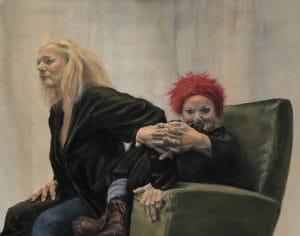 Flea has entered the building #1
Flea has entered the building #1
The clown remains seated, while the “ordinary woman” stands up. Her arm is encompassed by the clown. The clown also looks at us with a smile. Does she smile because she knows that the other person stays connected to her?
If you’ve been with the clown, can you really leave her behind? The clown also seems to take pleasure in it; she looks at us with a smile as she encloses the arm of the upright woman.
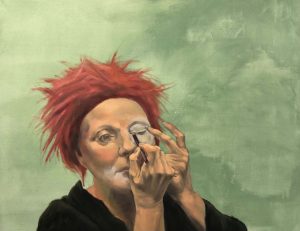 Flea has entered the building #2
Flea has entered the building #2
It’s about whether to be a clown. Here we see the transformation into clown. Has she already put on her wig? Or is it her real hair? She is busy doing the eyeliner. Her other eye, not yet made up, probably looks in the mirror. This eye guides her hands. Does her rationale, her ordinary thinking, still have control over the clown? Or is it gradually losing ground? Once you’re putting up the make-up for a clown, do you then automatically become a clown? When putting of the make-up, will the clown actually disappear?
 Flea has entered the building #3 (in particulier bezit)
Flea has entered the building #3 (in particulier bezit)
In the mirror we see her transformation into the clown. The make-up is almost finished, the transformation is almost complete…
But if we look closely at the face of the woman who we see on the back, we see that she does not have all the make-up that belongs to the clown. The figure in the mirror is already made up as a clown…
Who is the reflection here: the woman we can see on the back, or the woman facing us? Who is the starting point here?
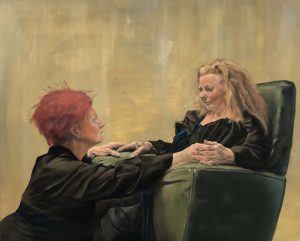 Flea has entered the building #4
Flea has entered the building #4
The clown sits in front of the chair and looks at the woman. They look into each other’s eyes, so there is contact, a connection. In addition to eye contact, there is also physical contact. The fingers of the clown’s left-hand rest on the woman’s right hand. The woman’s left hand encompasses the clown’s right hand.
What’s going on here? Who has the leading role here? The clown or the woman? Is there a request from the woman to the clown, or from the clown to the woman? Is it an invitation from the clown to the woman, or a reflection from the woman on the clown? Or is there rather some kind of balance? There is also a calm, a silence from the painting, as if there is a mutual understanding.
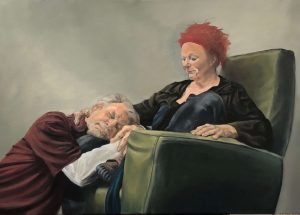 Flea has entered the building #5
Flea has entered the building #5
The man’s head rests in the clown’s lap. His eyes are closed. He lies relaxed with his hands crossed. The clown’s left hand covers his neck protectively. She looks at him as he lies there. Does she protect him? Does she take care of him?
He has, it seems, surrendered to her. Does he rest in her crazy-wisdom? Or is it actually surrendering to his own crazy-wisdom?

